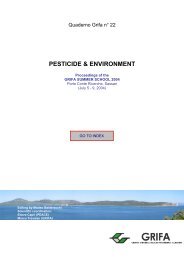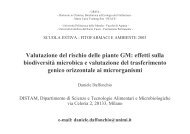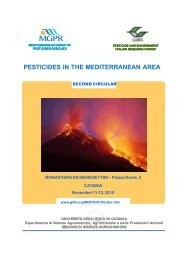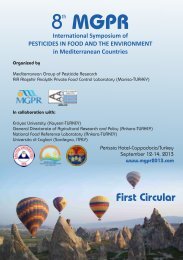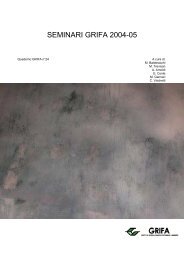International Congress BIOLOGICAL PRODUCTS - Gruppo di ...
International Congress BIOLOGICAL PRODUCTS - Gruppo di ...
International Congress BIOLOGICAL PRODUCTS - Gruppo di ...
You also want an ePaper? Increase the reach of your titles
YUMPU automatically turns print PDFs into web optimized ePapers that Google loves.
while for <strong>di</strong>nocap is 10 pg/µL. For the determination of sulfur residue, a HRGC Dani 86.10, fitted with a FPD Dani<br />
86/70 detector and a Mega 68 fused Silica column, were used; the detection limit was 2 ng/µL.<br />
Derivative potentiometric stropping analysis<br />
For metals determination an ION 3 Steroglass potentiometric stripping analyzer equipped with a conventional<br />
three electrodes cell, was used. The working electrode was a glassy carbon one covered with a thin mercury film.<br />
Before each analysis an appropriate volume of wine was treated with HCl 2M lowering the pH to 2, in order to ensure<br />
that all metals present remain in unbound –free forms. Cd (II), Cu (II) and Pb (II) were determined simultaniously, their<br />
oxidation potential were respectively –590 mV, -185 mV and –400mV. Zn was separately determined, its oxidation<br />
potential was –950 mV. Quantitative analysis was always carried out by the method of standard ad<strong>di</strong>tions.<br />
RESULTS and CONCLUSION<br />
The residues found in all wines were below the limits that Italian law (D.M. 19 may 2000) provides for grapes<br />
and wines. Particularly no quinoxyfen residues were found in the wines; also in wines originated from treated grapes,<br />
no <strong>di</strong>nocap residues were found probabily because of an inferior number of tratments applied on vines (table 1).<br />
Maximum accetable levels of Cd (II), Cu (II), Pb (II), and Zn (II) in wines, has been estabilished by the Italian<br />
Republic (5) and by the European Commission (6) respectively at 100<br />
ng L -1 , 1000 ng L -1 , 300 ng L -1 , and 500 ng L -1 . As tables 2 a-c evidence that the metals content of the stu<strong>di</strong>ed wines was<br />
always under the acceptable levels, particularly Cd was not found in any sample. The content of Cu, determined in<br />
wines coming from the three regions ranged from 10.5 to 415.7 ng mL -1 and was not influenced by fungicides<br />
treatments applied on grapes. The concentration of Pb spanned from 3.6 to 17.4 ng mL -1 and was regularly influenced<br />
by pesticides treatments (fig. 1): the highest amounts were extimated for samples treated only with sulfur and with<br />
azoxystrobin while the lowest were found in wines trated with quinoxyfen and <strong>di</strong>nocap. The level of Zn was in the range<br />
21.6-263.0 ng mL -1 and showed a regular behaviour respect to the treatments (fig.2) only in white wines: the highest<br />
amounts were extimated for samples treated with fenarimol and azoxystrobin, and as already observed, the lowest in<br />
samples treated with <strong>di</strong>nocap. For red wines the highest Zn contents were evaluated in samples treated with azoxstrobin<br />
and in the one trated with sulfur, the lowest in the sample treated with fenarimol.<br />
LITERATURE<br />
1. Fernadez-Cornejo, J. Environmental and economic consequences of technology adoption: IPM in<br />
viticulture. Agricultural Economics 1998, 18, 145-155.<br />
2. Golimowsky, J.; Valenta, P.; Wolfgang-Nurnberg, H. Toxic Trace Metals in Food II. A Comparative<br />
Study of The Levels of Toxic Trace Metals in Wine by Differential Pulse Ano<strong>di</strong>c Stripping Voltammetry and<br />
Electrothermal Atomic Absorption Spectrometry. Z.Lebensm. Unters. Forsh. 1979 b, 168, 439-443.<br />
3. Salvo, F.; La Pera, L.; Di Bella, G.; Nicotina, M.; Dugo, G.mo. Influence of mineral and organic<br />
pesticides treatments on Cd (II), Cu (II) Pb (II) and Zn (II) content determined by Derivative Potentiometric Stripping<br />
Analysis in Italian Red and white wines. J. Agric. Food Chem. 2003 in press<br />
4. Dugo, G.mo; Visco A.; Saitta M.; Vinci, V.; Di Bella G.Dosaggio <strong>di</strong> quinoxyfen su prodotti vitivinicoli<br />
siciliani. Vigne vini, 2001, 91, 7-8.<br />
5. Repubblica Italiana; Caratteristiche e Limiti <strong>di</strong> alcune Sostanze nel Vino. 1986, december D.M. 29.<br />
6. European Commission; 1997 Doc III/5125/95/ Rev.3.<br />
Table 1: Fungicide residues (µg /Kg + s.d.) in wine.<br />
azoxystrobin <strong>di</strong>nocap fenarimol penconazole quinoxyfen<br />
Sicily 21±6 n.d. 13±2 10±1 n.d.*<br />
Campania 5±1 n.d. 6±2 8±2 n.d.*<br />
Tuscany 12±2 n.d. 70±6 12±1 n.d.*<br />
n.d. < 10 µg /Kg<br />
n.d.* < 5 µg /Kg<br />
PDF creato con FinePrint pdfFactory versione <strong>di</strong>mostrativa http://www.secom.re.it/fineprint<br />
155



